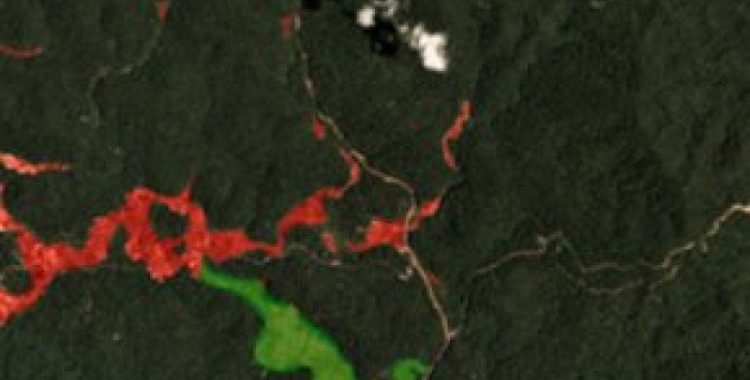“An impressive application of AI” is how Microsoft’s Bonnie Lei described the ASMSpotter solution, a partnership between Levin Sources and dida, when she awarded it the Conservation X Labs Artisanal Mining Grand Challenge Microsoft AI for Earth prize worth USD 100,000. This prestigious international award recognises the value and innovation of our solution, which was selected from over 100 entries from over 40 countries
ASMSpotter automatically identifies artisanal and small scale gold mining sites from satellite imagery. Congratulations dida Machine Learning, @levinsources, and @RWTH on this impressive application of AI! #AIforEarth #ASMGrandChallenge @conservationx https://t.co/9BEVxmSey6
— Bonnie Lei (@lei_bonnie) October 1, 2020
How does ASMSpotter work?
ASMSpotter uses AI algorithms to analyse satellite images from the European satellite Sentinel-2 of the European Space Agency ESA from the Copernicus program and from Planet, a commercial provider of satellite images. It automatically identifies artisanal and small-scale mine sites and can help to monitor change over time using time-lapse series.
The software helps public authorities and industry (large-scale mines, buyers, etc.) to effectively and continuously identify and monitor artisanal and small-scale gold mining (ASGM) over large geographic regions by automating the detection of ASGM sites through the application of Machine Learning and Computer Vision algorithms to satellite imagery.
It provides a powerful tool to gather baseline data on the evolution of the sector, including risk profiles of operations. Such data is an essential ingredient to inform effective, evidence-based policy making to regulate and support the development of the sector. This in turn generates efficiencies for government programming, better experiences of ASM governance by miners, and improved social and environmental outcomes for mining communities, in line with national and international legal and normative requirements. It can further be integrated into Key Biodiversity Area conservation activities, as well as responsible production and sourcing efforts to inform site identification, ASM engagement, impact assessment and risk management approaches.
ASMSpotter was initially developed by Germany-based machine learning experts dida in Suriname thanks to a grant from the European Space Agency. Levin Sources subsequently partnered with them to introduce upstream ground-truthing with a view to improving accuracy and usage functions, to build safeguards into how the solution is used, and to work with industry and the public sector to integrate the solution into ongoing ASM engagement and support strategies. The AI for Earth prize is a recognition of its innovative approach to ASM detection and monitoring.
“Governments using our solution can regulate the sector much better because they can detect changes and act early”
Upon receiving the prize, Robert Heesen, Director of Product at dida stated: "We feel very honored to be recognized by such an outstanding jury and by Microsoft. With ASMSpotter we want to show that AI can make a positive contribution to the big problems of humankind. ASMSpotter helps to minimise environmental destruction and improve the working conditions of the local population. Until now local authorities lack solutions for automatic, large-scale monitoring of mining activities. Governments using our solution can regulate the sector much better because they can detect changes and act early. Together with our partner, Levin Sources, we ensure that the solution is not misused and can develop its full potential.”
From Levin Sources’ side, we are excited to be a key contributor to such a promising initiative. Reflecting on the prize, Adam Rolfe, Senior Manager of Good, Governance evaluated its impact potential: “ASMSpotter can help to fill the enormous data gap that exists in relation to the ASM sector today. Whether you are a mining ministry working to regulate and support the sector, a refiner or a smelter sourcing from ASM or a large-scale mine that has ASM activity in and around your concession, the solution holds something for you. Only by better understanding the evolution of the sector can we hope to effectively engage with and support miners, who have an important role to play in contributing to the world’s resources needs in an environmentally friendly and sustainable manner”.
The ASMSpotter sounds great. When can I use it?
When it was initially tested in 2019 in northeastern Suriname, the ASMSpotter demonstrated that ASGM activity could be automatically detected - to 80-90% accuracy - based on training an AI algorithm with more than 10,000 PlanetScope and Sentinel-2 satellite images.
Based on this feasibility assessment, we know the solution to be effective for open pit gold mines within similar rainforest topographies. We have good reason to believe it can be successful across a range of minerals and topographies when trained with representative datasets. Heesen says that "Technically speaking, the AI solution is well scalable to other countries and raw materials. Now we are looking for partners who will work with us to ensure that the solution is used responsibly and effectively."
Following “proof of concept”, dida partnered with Levin Sources to build a holistic package for clients that harnesses the power of technology and good governance to contribute to better understanding and management of the sector. The good governance component of the solution involves working with trusted partners as part of existing initiatives to educate them on the responsible use of this powerful monitoring solution, for example as:
- a contributor to formalisation
- a tool for supply chain due diligence,
- for managing ASM-LSM interactions
- for managing illegal ASM in protected areas, and
- for mineral sector development planning.
The consortium will use the prize fund to:
- Pilot the solution within a limited geography in Ghana (letter of intent from Ministry of Land and Natural Resources already obtained)
- Further develop the governance modules for responsible usage of the solution
- Refine the technical solution by ground truthing and adding further training data sets
- Explore uses across different mineral and mining types and topographies
- Engage with potential clients to establish user needs and onboard new users
- Market and promote the solution



